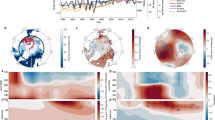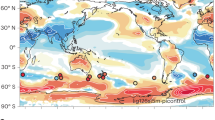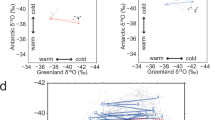Abstract
Temperature reconstructions from the North Atlantic region indicate frequent abrupt and severe climate fluctuations during the last glacial and Holocene periods1,2,3. The driving forces for these events are unclear and coupled atmosphere–ocean models of global circulation have only simulated such events by inserting large amounts of fresh water into the northern North Atlantic Ocean4,5. Here we report a drastic cooling event in a 15,000-yr simulation of global circulation with present-day climate conditions without the use of such external forcing. In our simulation, the annual average surface temperature near southern Greenland spontaneously fell 6–10 standard deviations below its mean value for a period of 30–40 yr. The event was triggered by a persistent northwesterly wind that transported large amounts of buoyant cold and fresh water into the northern North Atlantic Ocean. Oceanic convection shut down in response to this flow, concentrating the entire cooling of the northern North Atlantic by the colder atmosphere in the uppermost ocean layer. Given the similarity between our simulation and observed records of rapid cooling events, our results indicate that internal atmospheric variability alone could have generated the extreme climate disruptions in this region.
This is a preview of subscription content, access via your institution
Access options
Subscribe to this journal
Receive 51 print issues and online access
$199.00 per year
only $3.90 per issue
Buy this article
- Purchase on Springer Link
- Instant access to full article PDF
Prices may be subject to local taxes which are calculated during checkout




Similar content being viewed by others
References
Bond, G. et al. A pervasive millennial-scale cycle in North Atlantic Holocene and glacial climates. Science 278, 1257– 1266 (1997).
Dansgaard, W. et al. A new Greenland deep ice core. Science 218, 1273–1277 (1982).
Johnsen, S. J. et al. Irregular glacial interstadials recorded in a new Greenland ice core. Nature 359, 311– 313 (1992).
Manabe, S. & Stouffer, R. J. Simulation of abrupt climate change induced by freshwater input to the North Atlantic Ocean. Nature 378, 165–167 ( 1995).
Manabe, S. & Stouffer, R. J. Coupled ocean-atmosphere model response to fresh-water input: Comparison to Younger Dryas event. Paleoceanography 12, 321–336 (1997).
Woodgate, R. A., Fahrbach, E. & Rohardt, G. Structure and transports of the East Greenland Current at 75N from moored current meters. J. Geophys. Res. 104, 18059–18072 (1999).
Delworth, T., Manabe, S. & Stouffer, R. J. Multidecadal climate variability in the Greenland Sea and surrounding regions: a coupled model simulation. Geophys. Res. Lett. 24, 257–260 ( 1997).
Dickson, R. R., Meinke, J., Malmberg, S. A. & Lee, A. J. The “Great Salinity Anomaly” in the northern North Atlantic 1968–1982. Prog. Oceanogr. 20, 103– 151 (1988).
deMenocol, P., Ortiz, J., Guilderson, T. & Sarnthein, M. Coherent high and low latitude climate variability during the Holocene warm period. Science 288, 2198– 2202 (2000).
England, M. H. Using chlorofluorocarbons to assess ocean climate models. Geophys. Res. Lett. 22, 3051–3054 (1995).
Rabitaille, D. Y. & Weaver, A. J. Validation of sub-grid-scale mixing schemes using CFCs in a global model. Geophys. Res. Lett. 22, 2917–2920 (1995).
Kattenberg, A. et al. in Climate Change 1995: The Science of Climate Change 285–357 (Cambridge Univ. Press, Cambridge, 1996).
Hurrell, J. W. Decadal trends in the North Atlantic Oscillation regional temperatures and precipitation. Science 269, 676– 679 (1995).
Thompson, D. W. J., Wallace, J. M. & Hegerl, G. C. Annular modes in the extratropical circulation. Part II: trends. J. Clim. 13, 1018– 1036 (2000).
Manabe, S., Stouffer, R. J., Spelman, M. & Bryan, K. Transient responses of a coupled ocean-atmosphere model to gradual changes of atmospheric CO2. Part I: annual-mean response. J. Clim. 4, 785–817 ( 1991).
Manabe, S., Spelman, M. J. & Stouffer, R. J. Transient response of a coupled ocean-atmosphere model to gradual changes of atmospheric CO2. Part II: Seasonal response. J. Clim. 5, 105–126 ( 1992).
Manabe, S. & Stouffer, R. J. Multiple-century response of a coupled ocean-atmosphere model to an increase of atmospheric carbon dioxide. J. Clim. 7, 5–23 (1994).
Stouffer, R. J. & Manabe, S. Response of a coupled ocean-atmosphere model to increasing atmospheric carbon dioxide: Sensitivity to the rate of increase. J. Clim. 12, 2224 –2237 (1999).
Delworth, T., Manabe, S. & Stouffer, R. J. Interdecadal variation of the thermohaline circulation in a coupled ocean-atmosphere model. J. Clim. 6, 1993–2011 (1993).
Manabe, S. & Stouffer, R. J. Low frequency variability of surface air temperature in a 1000-year integration of a coupled ocean-atmosphere model. J. Clim. 9, 376– 393 (1996).
Manabe, S. & Stouffer, R. J. Two stable equilibria of a coupled ocean-atmosphere model. J. Clim. 1, 841– 866 (1988).
Gordon, C. T. & Stern, W. A description of the GFDL Global Spectral Model. Mon. Weath. Rev. 110, 625– 644 (1982).
Manabe, S. Climate and the ocean circulation: I. The atmospheric circulation and the hydrology of the Earth's surface. Mon. Weath. Rev. 97, 739–774 (1969).
Bryan, K. & Lewis, L. A water mass model of the world ocean. J. Geophys. Res. 84, 2503– 2517 (1979).
Marotzke, J. & Stone, P. Atmospheric transports, the thermohaline circulation, and flux adjustments in a simple coupled model. J. Phys. Oceanogr. 25, 1350–1364 (1995).
Acknowledgements
A.H. is supported by a Lamont Postdoctoral Fellowship. We thank G. Bond for useful discussions, and T. Delworth, P. deMenocal, I. Held, M. Elliot, M. Latif, J. Mahlman, S. Manabe and R. Wood for comments on the manuscript.
Author information
Authors and Affiliations
Corresponding author
Rights and permissions
About this article
Cite this article
Hall, A., Stouffer, R. An abrupt climate event in a coupled ocean–atmosphere simulation without external forcing. Nature 409, 171–175 (2001). https://doi.org/10.1038/35051544
Received:
Accepted:
Issue Date:
DOI: https://doi.org/10.1038/35051544
This article is cited by
-
Destabilisation of the Subpolar North Atlantic prior to the Little Ice Age
Nature Communications (2022)
-
A 7-ka climatic variability record inferred from peat bog sediments in the north of Bayan Har Mountains, northeastern Tibetan Plateau
Environmental Earth Sciences (2020)
-
Spatial analysis of early-warning signals for a North Atlantic climate transition in a coupled GCM
Climate Dynamics (2019)
-
Processes governing the predictability of the Atlantic meridional overturning circulation in a coupled GCM
Climate Dynamics (2011)
-
Modeled seasonality of glacial abrupt climate events
Climate Dynamics (2008)
Comments
By submitting a comment you agree to abide by our Terms and Community Guidelines. If you find something abusive or that does not comply with our terms or guidelines please flag it as inappropriate.



